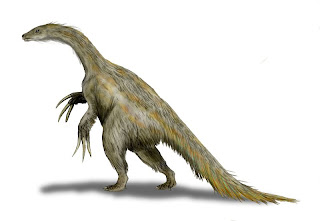 |
| Saurischian hip (from Wikimedia Commons user Muriel Gottrop) |
 |
| Ornithischian hip (from Wikimedia Commons user Muriel Gottrop) |
 |
| Pantydraco, a sauropodomorph from the British Isles. Image from Wikimedia Commons (user ArthurWeasley) |
Of course, the sauropodomorphs also include the sauropods, the largest animals to have ever lived on land. These include animals like Apatosaurus (check out our video on 'Whatever happened to Brontosaurus?'), Diplodocus, and the largest known from significant remains, Argentinosaurus. There are some unusual sauropods as well, like Amargasaurus, which had several large spines on its neck and back, and Saltasaurus, an armoured sauropod with armour like the ornithischian ankylosaurs.
 |
| Saltasaurus, an armoured sauropod from the Late Cretaceous |
The second group of saurischians is the theropods. The theropods include almost all truly carnivorous dinosaurs, as well as some herbivorous and insectivorous groups. Early theropods include Coelophysis, which is known from a large bone bed at Ghost Ranch, New Mexico, and Dilophosaurus, also from the U.S. The largest land carnivores ever were also theropods, like Tyrannosaurus rex, Spinosaurus, and Giganotosaurus. A large group of theropods is the dromaeosaurids, which are characterised by their large sickle-shaped claw on their second toe like Velociraptor, and Deinonychus. Like all dinosaur groups, theropods had their share of bizarre ones. There's Therizinosaurus, a herbivore which has metre-long claws used possibly to claw at tree bark, the ornithomimids, or bird-mimic dinosaurs, and the oviraptorosaurs. They were originally thought to be egg-thiefs, because of a fossil which was thought to be an Oviraptor stealing from a Protoceratops nest. However, it was later discovered that it was actually protecting a nest of its own eggs.
 |
| Nothronychus, a therizinosaur. Image from Wikimedia Commons user DinoGuy2. |
The final group of theropods is the birds. Birds evolved from the deinonychosaurs, a group that includes the dromaeosaurids and troodontids. Derived deinonychosaurs can be very similar to early birds, and can sometimes be hard to distinguish the two. Early birds include Archaeopteryx and Jeholornis, both from the Jurassic period.
 |
| The Berlin specimen of Archaeopteryx. Image from Wikimedia Commons user Vesta. |
Albertosaurus
Apatosaurus
Coelophysis
Ornitholestes
Troodon
Tyrannosaurus
Spinosaurus
Utahraptor
References:
http://palaeo.gly.bris.ac.uk/communication/boulton/evolution.html
No comments:
Post a Comment